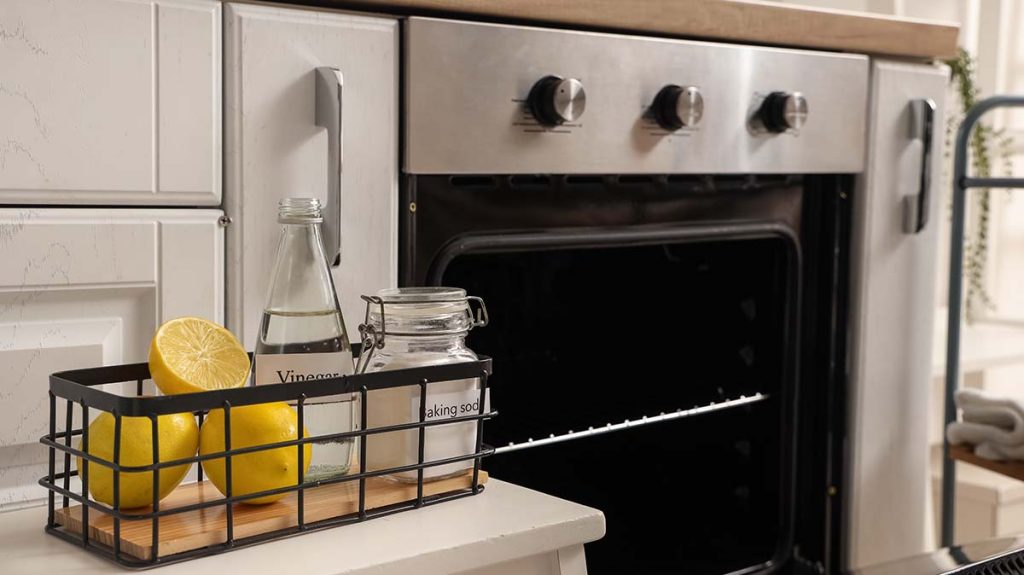Last update: 5 days ago

You’re getting ready to preheat for dinner, then find this all over your oven’s interior: burnt-on grease, splatters from last week’s roast, and unmovable crusty bits. The thought of getting down there with a scouring pad makes you want to order takeaway instead.
However, that stubborn grime can be taken care of without the need to scrub until your arm falls off and turning oven cleaning into a workout.
Cleaning the oven without scrubbing can actually feel doable. Let’s explore how to make it happen.
Clean the oven with baking soda and vinegar overnight
This method works shockingly well for how simple it is. Better yet, your muscles won’t be sore by the end of it.
Two everyday ingredients will be doing the heavy lifting while you sleep. Baking soda brings mild alkalinity to the table. It slices through grease on contact.
Vinegar handles what’s left. The tougher buildup breaks down under its acidity, and those lingering food smells disappear along with it. Combine the two and you’ll get a soft foam that lifts the muck right up.
Here’s what you’ll need:
- Half a cup of sodium bicarbonate or more;
- White vinegar;
- Water;
- A mixing bowl;
- A cloth or sponge;
- A spray bottle.
Clear out your appliance completely. Take out the racks first, the thermometers, then the pizza stones. Everything needs to come out so you can reach every surface inside. The racks will get their own treatment later, so set them aside for now.
Start by mixing up your paste. Toss about half a cup of baking soda in a bowl. Water comes next, but add it gradually in small amounts. The consistency matters here. You want something that glides on without resistance but clings to the surfaces that need it most.
Take your time with the water. It’s easier to make a thick paste runny than rescue one that’s turned to soup. Once it’s ready, do the following:
- Cover the inside surfaces with a generous layer. Work it across the sides, base, and door, making sure every spot gets a coating. If you’re using an electric model, skip the heating elements to avoid any trouble.
- Hit the worst spots with extra paste, and for those blackened areas, make sure to lather it on. Don’t worry when the paste starts turning brown. That’s just the buildup being drawn out.
- Close the door and leave it. The longer you give it, ideally, overnight or around twelve hours, the better it’ll loosen up all that baked-on mess. Alternatively, wait six hours minimum if you’re pressed for time.
- Come morning, grab a damp cloth or sponge and start clearing off the mixture. Most of the mess should come off without much fuss.
- If a few stubborn spots decide to put up a fight, don’t stress—a plastic scraper will sort them out in seconds. Leave the metal tools out of it unless you fancy new scratches on the inside of your stainless steel oven.
- The vinegar comes next. Load up your spray bottle and coat any lingering residue. A damp cloth is going to handle what remains. Keep at it until the surface stops feeling sticky.
- Finish with plain water to clear any lingering smell or that chalky film bicarb leaves behind, then use a damp cloth again to finish everything off, and that’s it! You’ve cleaned your oven without scrubbing.
Steam clean the oven with lemon or vinegar
Willing to try another effective, albeit more zesty, hack? Steam cleaning an oven involves heat and moisture getting into grime, softening it so everything wipes away without a fight. Throw lemon or vinegar into the water for an extra degreasing punch from the acidity.
This is brilliant for regular upkeep and lighter messes, but not so much when it comes to heavy carbonised grease that’s been welded on there for months. That’ll need something with more bite.
Here’s what you’ll need:
- A dish or baking tray;
- Water;
- 2-3 limes or a cup of your natural homemade oven cleaner;
- A cloth or sponge for wiping.
- Start with a dish of water. Limes work a treat if you’ve got a few lying around. Slice them in half and squeeze the juice straight into the water. The spent halves go in afterwards. The rinds add extra cleaning power as they heat up.
- Going with vinegar instead? Pour it straight into the water. Either way, you want roughly equal parts water and your acidic ingredient of choice.
- Slide the container inside. Set the temperature somewhere between 120-150°C and let it run for 30 to 45 minutes. As the water heats up, steam is going to fill the oven and work into those greasy spots.
- When the timer goes, switch everything off and crack the door open slightly. You want it cool enough so it won’t burn, but still warm. If you stand by for too long, all that heat working in your favour is going to dissipate.
- Take your cloth or sponge and wipe down the inside. The buildup should come away without much fuss. If any bits resist, another pass will do the trick.
Skip the hassle of oven cleaning
Book our professional service and enjoy a spotless, grease-free oven.
Relying on commercial no-scrub cleaners
Here’s another tip to clean your oven without scrubbing. At times, you need something that works right out of the bottle. No mixing, no overnight waiting.
Store-bought formulas dissolve baked-on food and burnt residue on contact. They’re stronger than household alternatives, so they’ll give fast results.
Follow the instructions to a T. Otherwise, you run the risk of ruining your unit or breathing in some really harmful fumes if you don’t.
Open the windows and set up a fan before you begin. Gloves are essential here. These solutions can irritate bare skin with prolonged contact.
Eco-friendly options exist if you prefer something gentler on your hands and the environment. They take longer but spare your lungs and the planet. Look for plant-based formulas or anything labelled ‘low-VOC.’
Use the self-cleaning option on your oven
These days, many ovens come with a self‑clean function. It cranks the temperature up so high that leftover food and grease just turn to ash. When it’s finished, you sweep or wipe away what’s left.
If you’re trying out methods to clean the oven without scrubbing, this is among the most effective. Here’s how to implement it: pull out the racks first, as that kind of heat will warp them beyond recognition.
Open a window too—the cycle creates smoke and some pretty strong odours as everything burns away. You’ll probably catch a burning smell, but don’t worry. That’s just the buildup turning to dust, which is exactly what you want.
Hit the button and wait. The cycle will take a few hours, so plan accordingly. Once it finishes and the unit cools down, grab a damp cloth and wipe out the ash. That’s it. No chemicals, no soaking, and no effort beyond the initial setup.
Can you use a dishwasher tablet for cleaning the oven?
You’ve likely stumbled across a hack online that says something like ‘here’s how to clean your oven with a dishwasher tablet without scrubbing.’ It probably recommends dampening the tablet and rubbing it across the unit interior until the mess vanishes, or using the steam method, but with a dishwasher tablet.
The trouble is, those tablets aren’t meant for oven cleaning. They’re full of concentrated detergents that can cling to surfaces. Fire up your oven afterwards, and you risk turning that residue into fumes.
While that grainy texture seems like it’d help scrub things down, it tears up enamel and ruins seals. Do it enough times and you’ll end up with rust, heat escaping, or components that don’t work anymore.
Just stick with the better options from earlier in the post. Or, if the buildup is too much, call in the experts.
That said, these products can be useful—just not inside your unit. They work brilliantly on the racks, which we’ll cover next.
How to clean oven racks without scrubbing
Funny enough, those dishwasher tablets that are too harsh for the oven itself work wonders on the racks. The results speak for themselves. You’ll see what we mean once you try out this method.
Fill your bathtub or a large sink with hot water and make sure that the racks are completely under the surface. Then, toss in a tablet or two and forget about them overnight or for a few hours if you’re in a rush.
In the morning, pull the racks out and rinse them under warm water. Most of the grime will wash straight off. For stubborn patches, a gentle wipe with a soft cloth is going to eliminate them completely.
Not keen on using tablets? The natural method does the job, too. Sprinkle bicarb on them, mist some vinegar, let the foam settle, then wash everything with water.
Cleaning oven racks without scrubbing makes the whole oven situation less grim. Dirty racks mean that muck ends up on your food and baking trays, which is nobody’s idea of appetising.
Give them a proper clean every few weeks and you won’t be staring down a carbonised nightmare later.
Professional oven care
Remove stubborn grease and restore your appliance to peak condition.
Takeaways
- A mix of bicarb and acetic acid is great for heavy buildup. Apply the mixture, leave it for 12 hours, then wipe away what’s loosened up.
- For lighter messes, steam cleaning with lemon or vinegar works well between deeper treatments. But burnt-on patches require stronger solutions.
- Commercial no-scrub cleaners deliver fast results. Just open windows for ventilation and actually follow the product instructions.
- Self-cleaning mode turns everything to ash while you wait. Pull the racks out first and expect some smoke during the cycle.
- Dishwasher tablets don’t belong inside the oven—they leave residue that becomes fumes when heated. Use them on the racks instead, where they actually work brilliantly.
- Don’t forget to treat the shelves every few weeks to avoid heavy grime and keep it from transferring onto your food and cookware.








